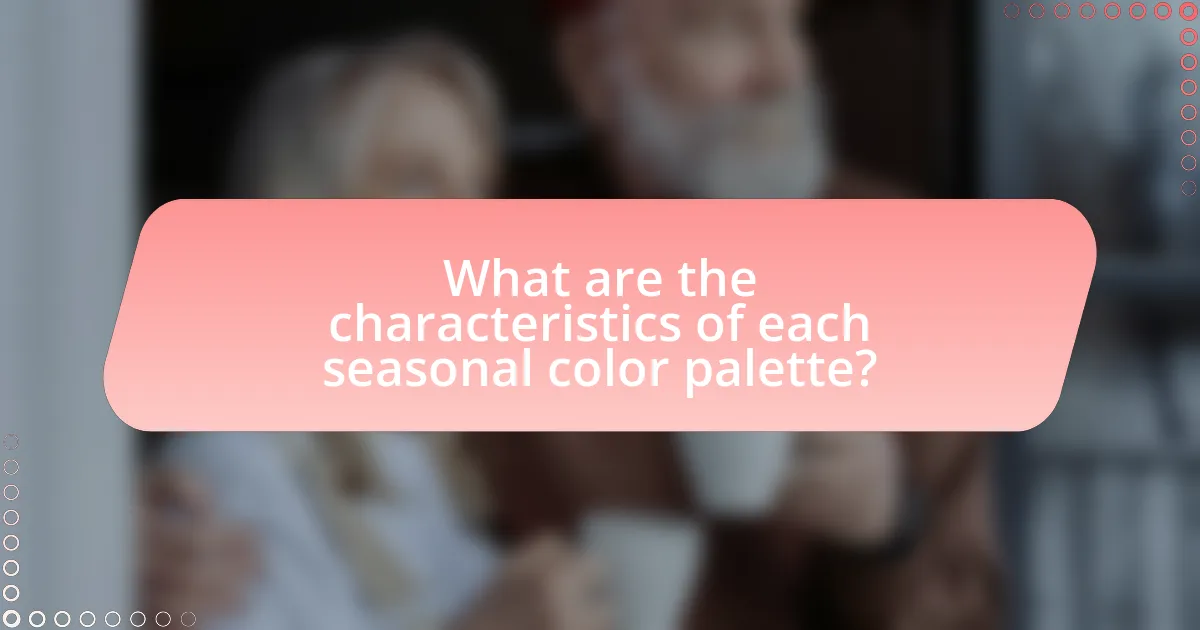Seasonal Color Analysis is a method that identifies an individual’s most flattering colors based on their skin tone, hair color, and eye color, categorizing them into four seasonal palettes: Winter, Spring, Summer, and Autumn. Each palette features distinct color characteristics that enhance natural features and improve personal style. The article explores how to determine one’s seasonal color type, the significance of undertones, and practical methods for incorporating seasonal colors into daily life, including wardrobe choices and accessories. Additionally, it discusses the psychological impact of color on personal image and confidence, as well as strategies for building a cohesive and flattering wardrobe.

What is Seasonal Color Analysis?
Seasonal Color Analysis is a method used to determine an individual’s most flattering colors based on their skin tone, hair color, and eye color. This analysis categorizes people into four seasonal palettes—Winter, Spring, Summer, and Autumn—each associated with specific color characteristics. The concept is rooted in color theory, which suggests that certain colors enhance a person’s natural features while others may detract from them. By identifying the seasonal palette that best suits an individual, they can make informed choices about clothing, makeup, and accessories, ultimately improving their overall appearance and confidence.
How does Seasonal Color Analysis categorize colors?
Seasonal Color Analysis categorizes colors into four distinct seasons: Spring, Summer, Autumn, and Winter. Each season represents a specific palette of colors that harmonize with an individual’s natural coloring, including skin tone, hair color, and eye color. For example, Spring colors are typically warm and bright, while Winter colors are cool and bold. This categorization is based on the theory that certain colors enhance an individual’s appearance, making them look more vibrant and healthy. The methodology often involves analyzing undertones and contrasts to determine the most flattering shades for each person.
What are the four main seasons in color analysis?
The four main seasons in color analysis are Spring, Summer, Autumn, and Winter. Each season represents a distinct palette of colors that complement different skin tones, hair colors, and eye colors. Spring features warm, bright colors; Summer showcases cool, soft hues; Autumn includes warm, earthy tones; and Winter is characterized by cool, vivid shades. This classification helps individuals identify the colors that enhance their natural features, making it a fundamental aspect of seasonal color analysis.
How do seasonal palettes differ from one another?
Seasonal palettes differ from one another primarily in their color characteristics, which are influenced by the seasons’ natural hues. Spring palettes typically feature bright, warm colors with a clear and vibrant quality, such as light pastels and fresh greens. In contrast, summer palettes consist of soft, cool colors that are muted and often include shades like lavender and soft blues. Autumn palettes are characterized by rich, warm, and earthy tones, such as deep oranges, browns, and golds, while winter palettes showcase bold, cool colors with high contrast, including jewel tones like emerald green and royal blue. This differentiation is rooted in the seasonal changes in nature, where each season presents distinct color schemes that evoke specific feelings and aesthetics.
Why is Seasonal Color Analysis important for personal style?
Seasonal Color Analysis is important for personal style because it helps individuals identify the colors that enhance their natural features and overall appearance. By understanding their seasonal color palette, individuals can make informed choices about clothing, accessories, and makeup that complement their skin tone, hair color, and eye color. This tailored approach not only boosts confidence but also promotes a cohesive and flattering wardrobe. Studies in color theory indicate that wearing colors aligned with one’s seasonal palette can significantly improve perceived attractiveness and personal satisfaction in style choices.
How can understanding your seasonal palette enhance your wardrobe?
Understanding your seasonal palette enhances your wardrobe by allowing you to select colors that complement your natural skin tone, hair, and eye color, resulting in a more cohesive and flattering appearance. When individuals wear colors from their seasonal palette, they often experience increased confidence and a more polished look, as these colors can brighten their complexion and enhance their overall aesthetic. Research in color theory indicates that wearing colors that align with one’s seasonal palette can lead to positive psychological effects, such as improved mood and self-perception, thereby reinforcing the importance of this analysis in wardrobe choices.
What impact does color have on personal image and confidence?
Color significantly influences personal image and confidence by affecting perceptions and emotional responses. Research indicates that specific colors can evoke feelings of power, calmness, or warmth, which in turn can enhance an individual’s self-esteem and how they are perceived by others. For example, a study published in the journal “Color Research and Application” found that wearing red can increase feelings of confidence and assertiveness, while blue is often associated with calmness and trustworthiness. These associations demonstrate that the colors individuals choose to wear can directly impact their self-image and the confidence they project to others.

How can you determine your seasonal color type?
To determine your seasonal color type, you can analyze your skin tone, hair color, and eye color to identify which seasonal palette complements your natural features. This process typically involves categorizing yourself into one of four seasons: Winter, Spring, Summer, or Autumn, based on the undertones of your skin—cool or warm—and the overall contrast of your coloring. For instance, individuals with cool undertones and high contrast often fall into the Winter category, while those with warm undertones and softer features may be classified as Spring or Autumn. This classification is supported by color theory, which suggests that certain colors harmonize better with specific undertones, enhancing your overall appearance.
What methods are used to identify your seasonal color type?
The methods used to identify your seasonal color type include draping, skin tone analysis, and color wheel assessments. Draping involves placing different colored fabrics against the skin to observe which shades enhance or detract from one’s natural features. Skin tone analysis categorizes individuals into warm, cool, or neutral undertones, which helps in determining the seasonal palette that complements their complexion. Color wheel assessments utilize a systematic approach to match personal coloring with seasonal categories—spring, summer, autumn, or winter—based on the harmony of colors. These methods are widely recognized in color theory and personal styling, providing a structured way to identify the most flattering colors for individuals.
How do skin tone, hair color, and eye color influence your seasonal type?
Skin tone, hair color, and eye color are critical factors in determining an individual’s seasonal type in color analysis. These characteristics help categorize individuals into seasonal palettes—Spring, Summer, Autumn, or Winter—based on their natural coloring. For instance, warm skin tones with golden undertones typically align with the Spring or Autumn palettes, while cool skin tones with pink or blue undertones are often associated with Summer or Winter palettes.
Hair color also plays a significant role; lighter hair shades like blonde or light brown often correspond with Spring or Summer types, whereas darker shades like deep brown or black are more common in Autumn or Winter types. Eye color further refines this classification; bright, clear eyes often indicate a Spring or Winter type, while muted or earthy tones suggest an Autumn or Summer type.
This systematic approach to color analysis is supported by the principles of color theory, which emphasize the harmony between an individual’s natural features and the colors that complement them best.
What role do undertones play in color analysis?
Undertones are crucial in color analysis as they determine how colors interact with an individual’s skin tone, influencing the overall harmony of their appearance. In seasonal color analysis, identifying whether a person’s undertones are warm, cool, or neutral helps in selecting colors that enhance their natural features. For instance, warm undertones typically pair well with earthy colors, while cool undertones are complemented by jewel tones. This alignment is supported by color theory, which states that colors can evoke different emotional responses and perceptions based on their undertones, thereby affecting personal style and confidence.
What tools and resources are available for color analysis?
Color analysis tools and resources include color swatches, digital color analysis software, and professional color consultants. Color swatches, often organized by seasonal palettes, allow individuals to visually compare and select colors that complement their skin tone. Digital color analysis software utilizes algorithms to analyze skin undertones and suggest suitable color palettes, enhancing the accuracy of color selection. Professional color consultants provide personalized assessments based on extensive training in color theory and seasonal analysis, ensuring tailored recommendations for individuals. These resources collectively facilitate effective color analysis, helping individuals identify their best colors for each season.
How can color swatches assist in identifying your best colors?
Color swatches assist in identifying your best colors by providing a visual reference that allows individuals to compare and contrast different shades against their skin tone, hair color, and eye color. This comparison helps in determining which colors enhance one’s natural features and which may be less flattering. Research in color theory indicates that certain colors can evoke specific emotional responses and perceptions, making it essential to select hues that align with personal style and seasonal palettes. By using swatches, individuals can effectively narrow down their choices to those that complement their unique characteristics, leading to more informed fashion and beauty decisions.
What online quizzes and consultations can help with color analysis?
Online quizzes and consultations that assist with color analysis include platforms like Color Me Beautiful, which offers a detailed online quiz to determine seasonal color types, and The Chic Fashionista, which provides a free color analysis quiz based on personal characteristics. Additionally, services like 30 Day Color Challenge offer personalized consultations that analyze individual skin tones and preferences to recommend suitable color palettes. These resources are validated by their popularity and user testimonials, demonstrating their effectiveness in helping individuals identify their best colors for seasonal dressing.

What are the characteristics of each seasonal color palette?
The characteristics of each seasonal color palette are defined by their unique color tones and overall warmth or coolness.
Spring palettes feature bright, warm colors with a clear and fresh quality, including shades like peach, coral, and light green. Summer palettes consist of soft, cool colors with a muted quality, such as lavender, soft pink, and powder blue. Autumn palettes are characterized by rich, warm colors with earthy tones, including burnt orange, olive green, and deep browns. Winter palettes showcase bold, cool colors with high contrast, featuring shades like royal blue, emerald green, and stark white.
These distinctions are based on the principles of color theory and seasonal color analysis, which categorize colors according to their temperature and intensity, helping individuals identify the hues that complement their natural coloring.
What colors are included in the Spring palette?
The Spring palette includes colors such as light pastels, soft pinks, peach, light yellow, mint green, and sky blue. These colors are characterized by their warm undertones and brightness, reflecting the freshness and vibrancy of the spring season. The Spring palette is often associated with a clear, bright aesthetic, which is supported by color theory that emphasizes the use of light and warm hues to evoke feelings of renewal and energy.
How do the qualities of Spring colors enhance personal style?
Spring colors enhance personal style by introducing vibrant, fresh hues that evoke a sense of renewal and energy. These colors, characterized by their lightness and brightness, complement various skin tones and can uplift an individual’s overall appearance. For instance, shades like soft pastels and bright floral tones can create a youthful and lively look, making outfits more visually appealing. Studies in color psychology indicate that bright colors can positively influence mood and perception, further reinforcing the idea that incorporating Spring colors can enhance personal style by not only improving aesthetic appeal but also boosting confidence and self-expression.
What are the best clothing choices for Spring types?
The best clothing choices for Spring types include light, warm colors such as peach, coral, and soft pastels. These colors complement the natural warmth and brightness associated with Spring types, enhancing their overall appearance. Fabrics like cotton and linen are ideal due to their breathable qualities, which align with the fresh and vibrant essence of Spring. Additionally, floral patterns and soft prints resonate well with this seasonal palette, reflecting the lively and cheerful characteristics of Spring.
What colors define the Summer palette?
The colors that define the Summer palette include soft pastels, cool tones, and muted shades. Specifically, this palette features colors such as lavender, soft pink, powder blue, mint green, and light gray. These colors are characterized by their cool undertones, which complement the lighter, airy aesthetic associated with the Summer season. The Summer palette is designed to enhance the natural beauty of individuals with cool skin tones, often found in those categorized as Summer in seasonal color analysis.
How do Summer colors complement a cooler skin tone?
Summer colors complement a cooler skin tone by enhancing the natural undertones present in individuals with this complexion. These colors, characterized by soft, muted shades like pastels and cool tones, harmonize with the pink or blue undertones typical of cooler skin tones. For example, colors such as lavender, soft pink, and light blue not only flatter but also create a balanced appearance, preventing the skin from looking washed out. This alignment is supported by color theory, which indicates that cool undertones are best complemented by similarly cool shades, thereby enhancing overall aesthetic appeal.
What accessories work well for Summer types?
Accessories that work well for Summer types include silver jewelry, pastel-colored scarves, and light, airy bags. These accessories complement the cool undertones and soft color palette typical of Summer types. Silver jewelry enhances the natural glow of Summer skin tones, while pastel scarves add a gentle touch that harmonizes with their overall look. Light bags in soft hues provide practicality without overwhelming the delicate aesthetic associated with Summer types.
What are the key colors in the Autumn palette?
The key colors in the Autumn palette include warm, earthy tones such as burnt orange, mustard yellow, deep red, olive green, and rich browns. These colors reflect the natural changes in foliage during the autumn season, characterized by their muted and warm qualities. The Autumn palette is designed to complement individuals with warm undertones in their skin, enhancing their natural features.
How do warm, earthy tones benefit Autumn types?
Warm, earthy tones benefit Autumn types by enhancing their natural warmth and richness in complexion. These colors, such as rust, olive green, and mustard yellow, complement the golden undertones typical of Autumn types, making their skin appear more vibrant and healthy. Research in color theory indicates that individuals with warm undertones often look best in colors that mirror the hues found in nature during the fall season, reinforcing their overall appearance and confidence.
What styles and fabrics are recommended for Autumn palettes?
Autumn palettes are best complemented by styles and fabrics such as rich, earthy tones and textured materials. Recommended fabrics include wool, cashmere, and corduroy, which provide warmth and depth, aligning with the seasonal aesthetic. These materials not only enhance the visual appeal but also offer comfort during cooler temperatures. The use of colors like burnt orange, deep reds, and olive greens in clothing aligns with the natural hues of autumn foliage, reinforcing the connection between fashion and the season’s characteristics.
What colors are associated with the Winter palette?
The colors associated with the Winter palette include cool, vivid shades such as icy blues, bright whites, deep blacks, and jewel tones like emerald green, royal blue, and fuchsia. These colors are characterized by their clarity and intensity, which complement the cool undertones typical of individuals classified within the Winter seasonal color analysis. The Winter palette is defined by its high contrast and boldness, making it distinct from other seasonal palettes.
How do bold, vibrant colors enhance the Winter type’s appearance?
Bold, vibrant colors enhance the Winter type’s appearance by providing a striking contrast that highlights their cool undertones and brightens their overall look. The Winter type typically has a high contrast between their hair, skin, and eye colors, making them particularly suited to bold shades like royal blue, emerald green, and fuchsia. These colors not only complement their natural coloring but also create a dynamic visual impact, drawing attention to their features. Research in color theory indicates that high saturation colors can evoke a sense of energy and confidence, which aligns with the Winter type’s inherent characteristics.
What are the best fashion choices for Winter types?
The best fashion choices for Winter types include bold, cool colors such as jewel tones, icy shades, and stark contrasts. Winter types typically look best in colors like emerald green, royal blue, and pure white, which enhance their natural coloring. These colors are often associated with the Winter palette, characterized by high contrast and clarity. Additionally, fabrics with a crisp finish, such as silk, wool, and cashmere, complement the sharpness of Winter types, providing a sophisticated look. The effectiveness of these choices is supported by the principles of Seasonal Color Analysis, which emphasize that Winter types thrive in vibrant, cool hues that reflect their inherent color characteristics.

How can you apply Seasonal Color Analysis in your daily life?
You can apply Seasonal Color Analysis in your daily life by identifying your seasonal color palette and incorporating those colors into your wardrobe, makeup, and accessories. This method enhances your natural features, as colors that align with your seasonal type—spring, summer, autumn, or winter—complement your skin tone, hair, and eye color. For instance, individuals classified as “winter” typically look best in cool, vibrant colors like jewel tones, while “autumn” types shine in warm, earthy hues. Research indicates that wearing colors that suit your seasonal profile can boost confidence and improve overall appearance, as supported by studies on color psychology and personal branding.
What practical tips can help you incorporate your seasonal colors?
To incorporate your seasonal colors effectively, start by identifying your seasonal palette based on your skin tone, hair color, and eye color. For example, if you are a Spring type, opt for warm, bright colors like coral and light green. Next, integrate these colors into your wardrobe by selecting clothing items, accessories, and makeup that align with your seasonal palette. For instance, a Summer type can wear soft pastels and muted tones, while an Autumn type should choose earthy hues like rust and olive. Additionally, use seasonal colors in your home decor to create a cohesive aesthetic that reflects your personal style. This approach not only enhances your appearance but also boosts your confidence by ensuring that the colors you wear complement your natural features.
How can you build a capsule wardrobe based on your seasonal palette?
To build a capsule wardrobe based on your seasonal palette, first identify your seasonal color type—spring, summer, autumn, or winter—through a color analysis. Once your seasonal palette is determined, select versatile clothing pieces that align with your color scheme, focusing on neutral base items and accent colors that complement your palette. For example, if you are a summer type, choose soft pastels and cool tones for your wardrobe staples. This method ensures that all items can be mixed and matched, maximizing outfit combinations while maintaining a cohesive look. Studies in color theory support that wearing colors that harmonize with your natural tones enhances overall appearance and confidence.
What are some common mistakes to avoid in color selection?
Common mistakes to avoid in color selection include ignoring skin undertones, failing to consider the context of use, and not testing colors in different lighting. Ignoring skin undertones can lead to choices that clash with an individual’s natural coloring, resulting in an unflattering appearance. Failing to consider the context, such as the setting or purpose of the color application, can result in colors that do not convey the intended message or mood. Additionally, not testing colors in various lighting conditions can cause discrepancies in how colors appear, leading to dissatisfaction with the final outcome.
How can you adapt your seasonal colors for different occasions?
To adapt your seasonal colors for different occasions, select shades that align with the event’s formality and mood. For instance, vibrant colors suited for casual gatherings can be toned down with neutral accessories for professional settings. Research indicates that color psychology influences perceptions; for example, blue conveys trustworthiness, making it ideal for business meetings, while warmer tones like red can evoke excitement, suitable for social events. By strategically choosing colors that reflect the occasion’s context, you enhance your overall appearance and appropriateness.
What strategies can you use to mix and match seasonal colors effectively?
To mix and match seasonal colors effectively, utilize a color wheel to identify complementary and analogous colors within your seasonal palette. This strategy allows for harmonious combinations that enhance your overall look. For instance, if you are in the spring category, pairing soft pastels with vibrant hues can create a balanced outfit. Additionally, consider the 60-30-10 rule, where 60% of your outfit is a dominant color, 30% is a secondary color, and 10% is an accent color, ensuring a cohesive appearance. Research indicates that color harmony can significantly impact visual perception and emotional response, reinforcing the effectiveness of these strategies in achieving a polished look.
How can you transition your wardrobe between seasons while staying true to your palette?
To transition your wardrobe between seasons while staying true to your palette, incorporate layering techniques and versatile pieces that align with your color scheme. For example, select lightweight fabrics in your seasonal colors that can be layered with heavier items as temperatures change. This method allows for adaptability while maintaining a cohesive look. Additionally, integrating accessories in your palette can enhance outfits without requiring a complete wardrobe overhaul. Studies in color theory indicate that consistent use of a defined color palette can improve personal style coherence and confidence.
What are the benefits of understanding your seasonal colors?
Understanding your seasonal colors enhances personal style and boosts confidence. By identifying the colors that complement your skin tone, hair, and eye color, individuals can make more informed choices in clothing and makeup, leading to a more harmonious appearance. Studies in color theory indicate that wearing colors that align with one’s seasonal palette can improve overall mood and perception, as colors can influence emotions and how others perceive an individual. For example, a study published in the Journal of Experimental Psychology found that colors can affect people’s feelings and judgments, reinforcing the importance of selecting colors that resonate with one’s natural features.
How does knowing your best colors save time and money when shopping?
Knowing your best colors saves time and money when shopping by allowing you to make quicker, more informed purchasing decisions. When individuals are aware of the colors that complement their skin tone, hair, and eye color, they can efficiently narrow down their options, reducing the time spent browsing through items that may not suit them. This targeted approach minimizes impulse buys and returns, which are often costly and time-consuming. Studies indicate that consumers who utilize color analysis are less likely to purchase items that remain unworn, leading to significant savings over time.
What long-term advantages does Seasonal Color Analysis offer for personal branding?
Seasonal Color Analysis provides long-term advantages for personal branding by enhancing an individual’s visual identity and ensuring consistent, appealing presentation. This method allows individuals to identify colors that complement their natural features, which can lead to increased confidence and a stronger personal presence. Research indicates that color can significantly influence perceptions; for instance, studies show that people make judgments about others’ professionalism and trustworthiness within seconds based on color choices. By utilizing Seasonal Color Analysis, individuals can strategically select clothing and branding materials that resonate with their target audience, ultimately fostering a more memorable and impactful personal brand.


